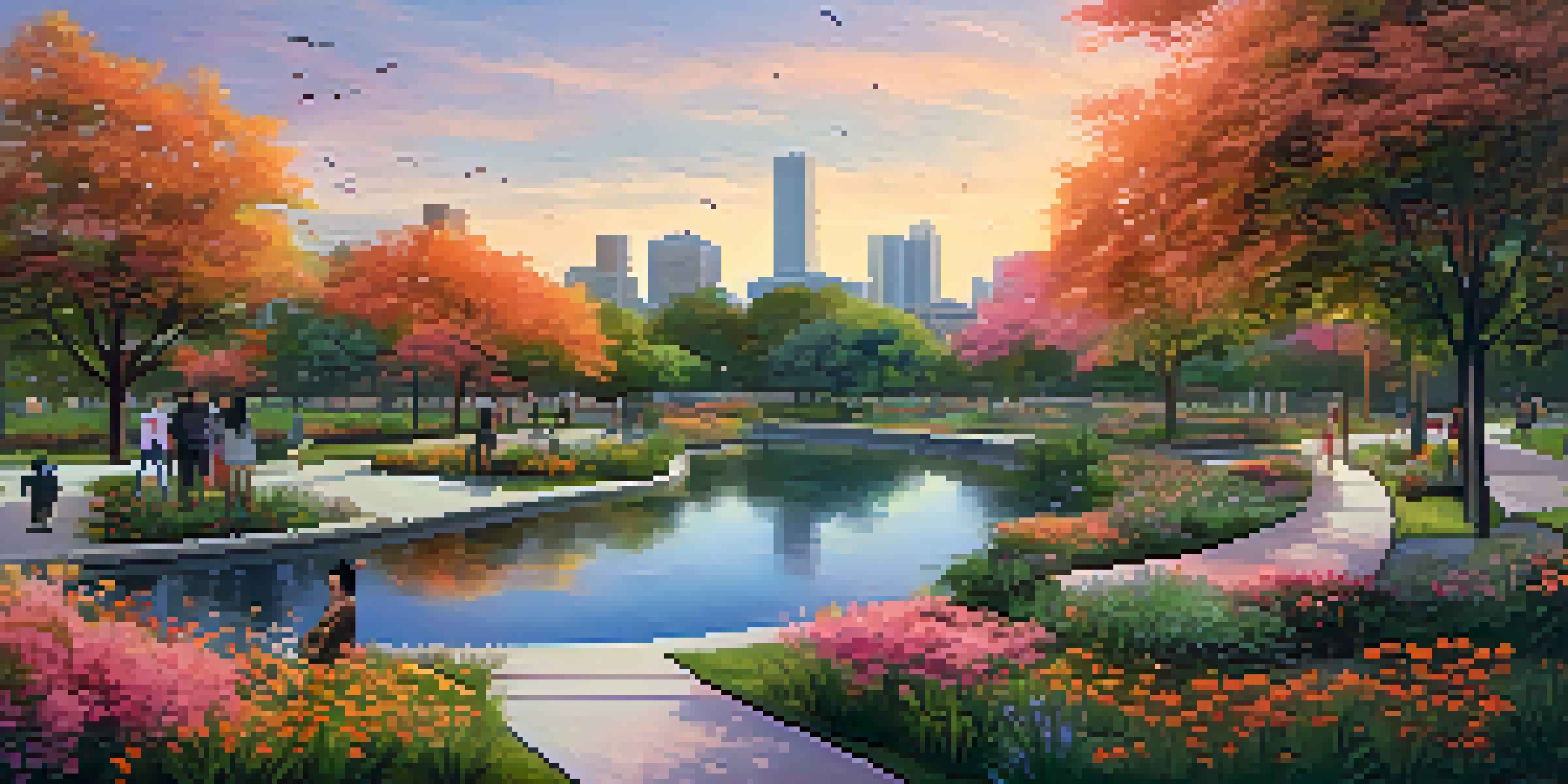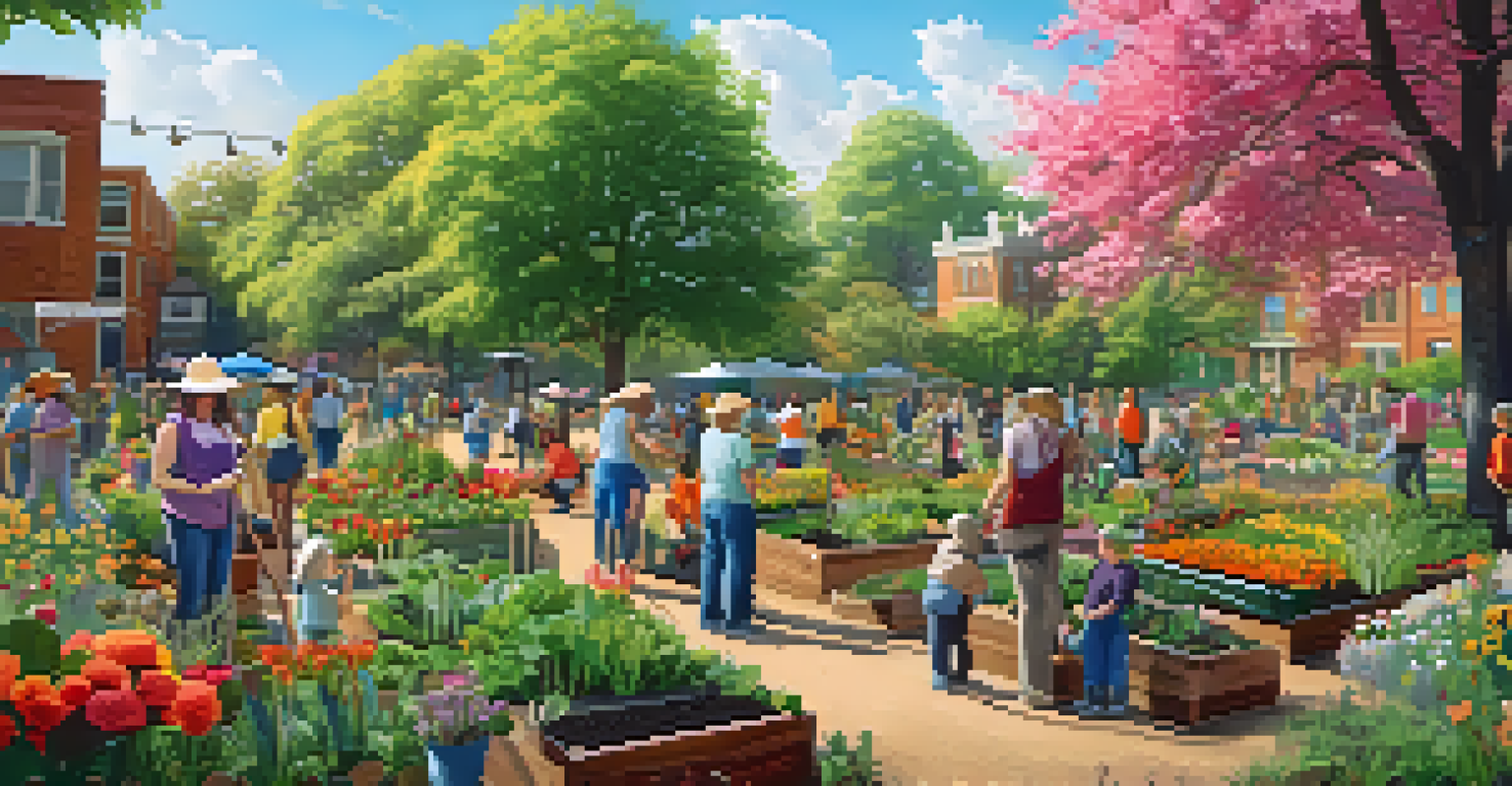Parks and Green Spaces: Promoting Biodiversity in Cities

Introduction: The Role of Urban Green Spaces
Urban green spaces, such as parks and gardens, play a crucial role in promoting biodiversity in cities. They provide essential habitats for various species, from birds to insects, enabling them to thrive amidst urban development. As cities expand, these green oases become vital for maintaining ecological balance and supporting wildlife populations.
In every walk with nature one receives far more than he seeks.
Beyond just aesthetics, these spaces contribute to the overall health of urban ecosystems. They act as green corridors, allowing wildlife to navigate through concrete jungles safely. This interconnectedness between nature and urban life highlights the importance of integrating biodiversity into city planning.
Moreover, green spaces enhance the quality of life for city dwellers. They offer recreational opportunities, improve air quality, and reduce urban heat, making them essential for both people and wildlife. Understanding their multifaceted benefits is key to advocating for their preservation and expansion.
Biodiversity Benefits of Urban Parks
Urban parks serve as critical habitats for a diverse range of flora and fauna. By incorporating native plant species in park designs, cities can create environments that support local wildlife, such as butterflies, birds, and small mammals. This biodiversity is essential for ecosystem resilience, allowing urban areas to adapt to environmental changes.

Additionally, parks can help restore populations of endangered species by providing safe nesting and feeding grounds. For example, planting native trees and shrubs can attract pollinators like bees, which are vital for maintaining plant diversity and producing food. Such initiatives can significantly enhance biodiversity in urban settings.
Urban Parks Boost Biodiversity
Urban parks create essential habitats for wildlife, promoting biodiversity and supporting local ecosystems.
Furthermore, parks are not just about preserving existing species; they can also promote the introduction of new ones. By creating varied habitats, such as wetlands or woodlands, cities can attract different wildlife, fostering a dynamic and thriving ecosystem. This biodiversity ultimately contributes to a more balanced urban environment.
How Parks Mitigate Urban Heat Island Effect
One of the pressing challenges urban areas face is the urban heat island effect, where cities become significantly warmer than surrounding rural areas. Parks and green spaces play a vital role in mitigating this phenomenon by providing shade and cooling the air through evapotranspiration. This natural cooling effect not only benefits wildlife but also enhances comfort for residents.
The best time to plant a tree was twenty years ago. The second best time is now.
Moreover, by reducing temperatures, these green spaces can decrease energy consumption for cooling buildings. This translates to lower carbon emissions and a healthier urban environment. For instance, a well-placed park can lower the surrounding temperature by several degrees, making a noticeable difference during hot summer months.
Incorporating more parks into urban planning can thus be seen as a dual solution: combating heat while promoting biodiversity. This synergy highlights the importance of viewing urban greenery not just as a luxury, but as a necessity for sustainable city living.
Creating Wildlife Corridors in Urban Areas
Wildlife corridors are essential for facilitating the movement of species between fragmented habitats. Urban parks can serve as these corridors, bridging gaps between green spaces and allowing wildlife to thrive. By designing parks with connectivity in mind, cities can create a network that supports biodiversity, enabling species to find food and mates more easily.
For instance, planting trees and shrubs along pathways can encourage birds and small mammals to traverse urban areas safely. This approach not only enhances biodiversity but also fosters an appreciation for nature among city residents. Observing wildlife in familiar settings can deepen community connections to local ecosystems.
Green Spaces Combat Urban Heat
Parks help mitigate the urban heat island effect by providing shade and cooling, enhancing comfort and reducing energy costs.
Additionally, enhancing urban parks with features like ponds or native gardens can attract a wider variety of species. Such intentional designs create inviting habitats that encourage wildlife to return, enriching the urban landscape. This holistic view of urban planning can transform cities into vibrant ecosystems.
Community Involvement in Green Space Conservation
Community involvement is crucial for the success of urban parks and green spaces. Local residents can play an active role in conservation efforts, from participating in planting days to advocating for the preservation of existing parks. Engaging the community fosters a sense of ownership and responsibility towards these vital resources.
Education is also key to community involvement. Programs that teach residents about local biodiversity and the importance of green spaces can inspire action. Workshops, school programs, and volunteer opportunities can create a deeper understanding and appreciation for the natural world within urban settings.
Moreover, community-led initiatives can lead to innovative solutions for enhancing biodiversity. By collaborating with local organizations and experts, residents can contribute to the planning and maintenance of parks, ensuring that they meet both ecological and social needs. This partnership can transform urban green spaces into thriving habitats for both people and wildlife.
The Economic Value of Urban Green Spaces
Investing in parks and green spaces not only benefits biodiversity but also has significant economic implications. Well-maintained parks can increase property values in surrounding areas, attracting new residents and businesses. This economic boost highlights the importance of green spaces as a valuable asset to urban communities.
Moreover, parks can reduce city spending on health care and environmental management. By improving air quality and providing recreational areas, they can lead to healthier populations, reducing healthcare costs associated with pollution and sedentary lifestyles. The long-term savings can be substantial, making a strong case for investment in urban greenery.
Community Engagement is Essential
Active community involvement in conservation efforts fosters a sense of ownership and leads to innovative solutions for maintaining urban green spaces.
Additionally, parks can boost local economies through tourism and recreational activities. Events held in these spaces, from farmers' markets to outdoor concerts, can draw visitors and stimulate local businesses. This economic activity further underscores the multifaceted benefits of prioritizing parks and green spaces in urban planning.
Conclusion: The Future of Biodiversity in Urban Settings
As cities continue to grow, the integration of parks and green spaces into urban planning will be crucial for promoting biodiversity. These areas serve as vital refuges for wildlife while enhancing the quality of life for residents. A future where cities prioritize green spaces can lead to healthier ecosystems and communities.
Looking ahead, urban planners and communities must work together to create a vision for sustainable cities. This collaboration can ensure that biodiversity remains a core focus in development projects. By valuing and investing in green spaces, cities can foster environments where both people and wildlife can thrive.

Ultimately, the path to sustainable urban living lies in our ability to blend nature with city life. By promoting biodiversity through parks and green spaces, we can cultivate resilient cities that embrace the wonders of the natural world, enriching our lives and the ecosystems around us.